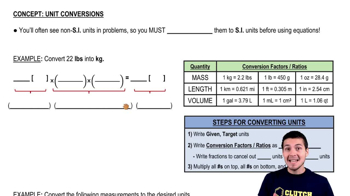Here are the essential concepts you must grasp in order to answer the question correctly.
Speed of Sound
The speed of sound is the distance traveled per unit time by a sound wave as it propagates through a medium. In air, this speed is influenced by factors such as temperature, humidity, and pressure. Generally, sound travels faster in warmer air because the molecules are more energetic and can transmit the sound waves more quickly.
Recommended video:
Effect of Temperature on Sound Speed
Temperature significantly affects the speed of sound in air. As temperature increases, the speed of sound also increases due to the greater kinetic energy of air molecules, which facilitates faster wave propagation. Conversely, at lower temperatures, the speed of sound decreases, as the molecules move more slowly and transmit sound waves less efficiently.
Recommended video:
Conversion of Temperature Units
To accurately calculate the speed of sound at different temperatures, it is often necessary to convert temperatures from Fahrenheit to Celsius or Kelvin. The formula for conversion is °C = (°F - 32) × 5/9. Understanding this conversion is crucial for applying the correct temperature values in the equations that determine the speed of sound.
Recommended video:



